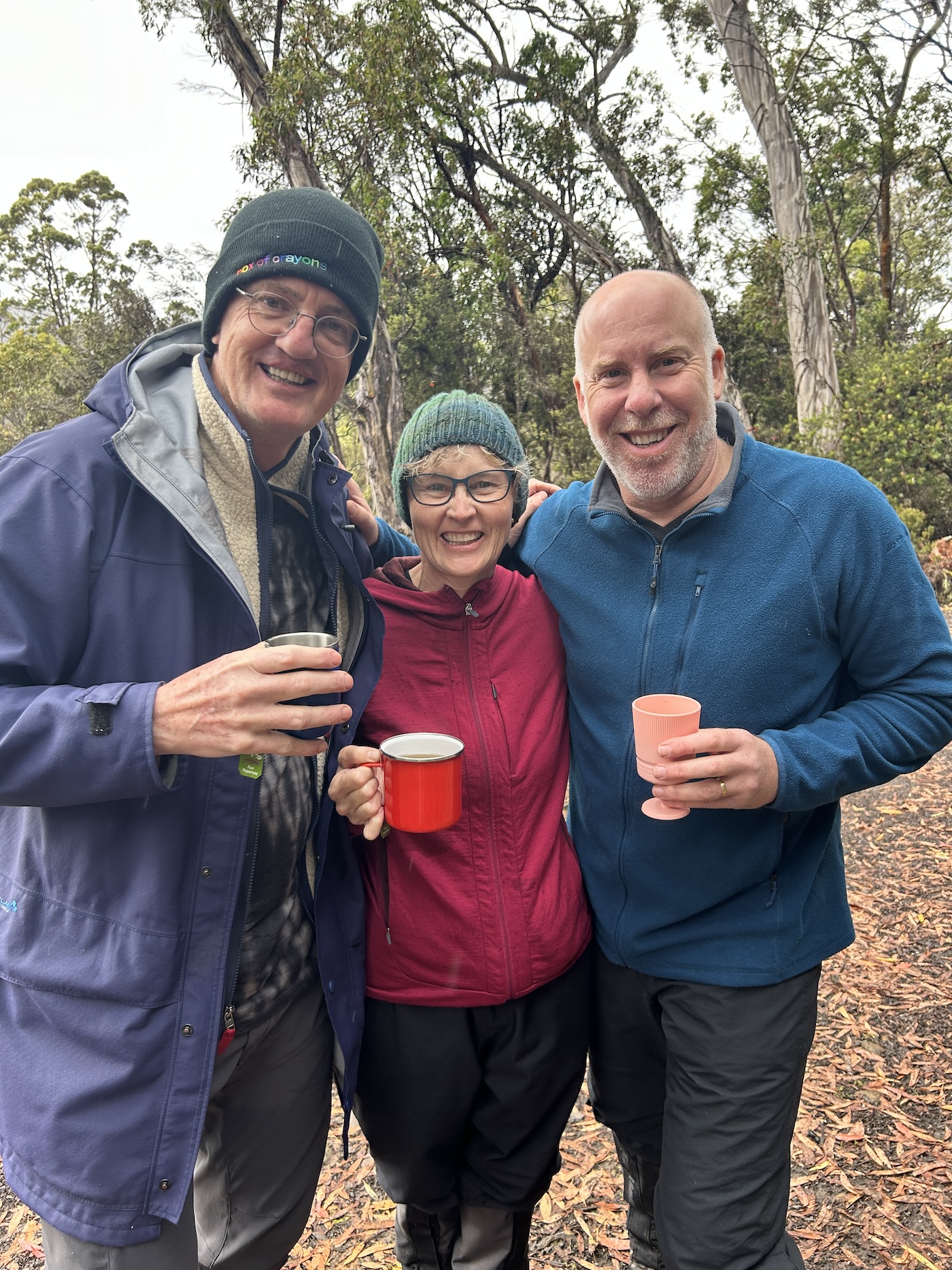End of the Overland Trail, with my friends Gabs and Batch
Three Unexpected Life Lessons from my Tasmanian Hike
The Overland Trail in Tasmania is one of the great walks of the world. If you’re one of those people who enjoy hiking in nature, you should be adding it to your “make this happen” list right now, and you can thank me later.
There are day walk options, but I did a six-day hike, something made possible first by two guides who schlepped food and equipment, and second by a series of pretty delightful huts where we slept each night.
Our group of ten each carried 11 kg/25lb packs, heavy enough to feel the weight, but not so heavy to be brought to my knees; but make no mistake: we were doing the “old and well-resourced” version of the hike.
There were a multitude of Track-Wisdom-That’s-Really-Life-Wisdom moments, and you should feel confident that these insights will be appearing in the coming months.
But let me start now with three of my favourite insights, all variations on a theme.
1. Let the Leech Suck You
Cradle Mountain, the national park where we hiked, is a damp part of the world. We had one day of torrid weather — fierce winds, obscuring mists, vertical rain — a couple of days of steady rain that enlivened the bush (Australian for “forest”) and made it shine, and a few days of blue sky and sunshine.
Whatever the weather, there wasn’t a single day when leeches weren’t a strong possibility. Perhaps you’re like me, and your reaction to finding a leech on you is to scream, flap your hands, panic, and shout, “get it off, get it off”.
Eleanor, one of the guides, suggested something else. Just let the leech suck you and take its fill.
What?
Her point was that after they’ve latched on, the damage is already done. It’s a little sting, and then you bleed a bit (when the leech bites, it spits in some anticoagulant).
But if you try and rip it off, you’ll likely flick the body away, LEAVING ITS MOUTH STILL ATTACHED (caps for deliberate emphasis), leaving you open to possible infection.
The point is this: a leech bite & suck feels horrible, but it’s actually a minor discomfort. Sit still, breathe, and it too shall pass. Overreacting to minor things can just make things worse.
(Burt, our other guide, said he “tickled them off”. I like the sound of that, but I never quite found out what it meant.)
2. The Puddles Aren’t Deep*
The equipment list we were sent had “waterproof boots” in bold and underlined, and my mum gave me a fantastic pair for my birthday. I’d worn them around Toronto a bit, but when I arrived at the start of the walk, they still looked pretty pristine.
The six days were a constant trek through water and mud, and on the first day, I was leaping around trying to avoid the puddles, trying to protect the boots.
On Day Three, Burt explained the wise thing to do was to walk through the puddles. The dark water – tannin and topsoil – made them look like they’d be deep, but most of them were just a couple of inches deep at most. By trying to avoid them, not only did you risk turning an ankle, but most times you also damaged the land beside the track, churning it into the bog.
“Protecting the boots” from the water made as much sense as not putting a car into the fourth drive to “protect the gear box”.
The length we go to avoid imagined obstacles can be exhausting, and make things harder than they need to be. Often enough, the way through it is simply through it. Keep walking.
(*That said, the occasional puddle is deep. Hiking poles are helpful for not just keeping your balance, but sounding out the depth of the puddle in front of you. They help you test reality.)
Your Boots Are Always Damp
By the end of Day One, the Hurricane Day, there wasn’t a part of me that wasn’t damp. Every 20 minutes, I’d have to stop and wring out about a gallon of water from my gloves. What liquid hadn’t seeped in from outside was generated by the sweat of walking. I was hot and cold in almost equal measures.
The good news (and a touch of luxury) was that the huts we stayed in had drying rooms, places to hang clothes, rinse out socks, and dry your boots next to a hot air blower.
But Burt cautioned danger. Try to dry your boots too fast, and you run the danger of overheating things and your sole peeling off.
Besides, Burt said (and this was the real wisdom), on this trip, your boots are always damp. Even when they’re dry, they’re damp … or just about to be.
Byron Katie said, “when you argue with reality, you lose but only 100% of the time”. So many of our worries and our drama come from an imagined better past or better future. The boots were dry. The boots will be dry. The boots should be dry.
Knowing that the boots are always damp — reality — calmed me down. I stopped arguing with reality, and I could enjoy what it was.
And as a bonus, I kept my soles.
Want The Works in your inbox? Sign up (free) here

